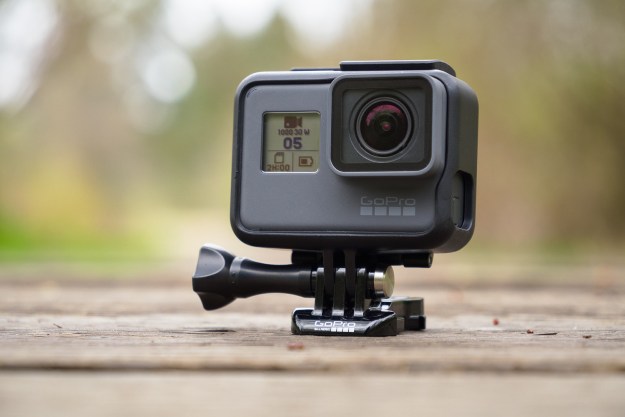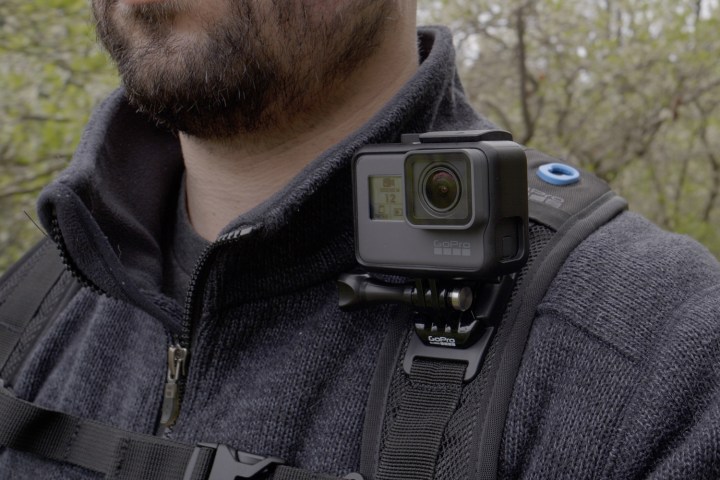
- Built-in touchscreen
- Waterproof without a case
- Great mobile apps
- Voice control
- Very easy to use
- Lacks ProTune
- Limited resolution and frame-rate options
- Interface has basic options from Hero5/Hero6
- Some cheaper cameras have more features
GoPro’s entry-level camera for 2018 is its least exciting to date, but that’s kind of the point. It’s a no-frills action camera that emphasizes simplicity and ease-of-use over raw power, and it bears an equally no-frills name: Hero — no number, no color. It lacks the high-end specifications of the Hero6 Black, and is even outclassed by 2016’s Hero5 Black, but at $200, it brings core aspects of GoPro’s current Hero family to the lowest price yet.
The GoPro Hero isn’t the camera for power users, and current Hero Black-series owners may find it difficult to integrate Hero footage with those from the more advanced siblings, but first-time action camera buyers and casual users will find a lot to love. The Hero represents a carefully curated selection of features designed to get you up and running as quickly as possible. While at times we found its limitations to be frustrating, more often than not, we appreciated its simplicity.
Design, specifications, and image quality
The Hero looks identical to the Hero5/Hero6 Black cameras. It uses the same rubberized, matte-gray body that’s waterproof down to 33 feet without the need for an underwater case. It has the same two-button interface, front LCD information display, and rear touchscreen. Connectivity is also the same, with USB-C, HDMI, and both Wi-Fi and Bluetooth.
Internally, the Hero uses a 10MP sensor and video resolution is limited to Full HD 1080p. That’s right, no 4K here. (It does offer a 1440p mode, but this forces the camera into a 4:3 aspect ratio.) Frame rate can be set to either 30 or 60 frames per second (fps); there’s no 24 fps option, nor is there the ability to shoot higher frame rates at lower resolutions like the Black-series cameras can. In fact, there are no lower resolutions at all; the Hero can’t shoot in 960p, 720p, 480p, or anything else below 1080p.
Frankly, we’re not bothered by the lack of 4K or high frame rates. For what action cameras are typically tasked with, 1080p is just fine — it’s the content that matters, not the pixels. Yes, we enjoy having the option for
GoPro’s latest camera is its least exciting, but that’s kind of the point.
The Hero also maintains image stabilization, another great feature for beginners who are less likely to be using a gimbal. It appears to be the same stabilization as the Hero5 Black, cropping the field of view by 10 percent. The Hero6 Black definitely has better stabilization thanks to its GP1 processor, but we’re glad to see any sort of stabilization on the new Hero.
As for video quality, it really isn’t bad. If you’re viewing footage at 100 percent on a computer, you’ll definitely notice some softness and lack of fine details. However, this looks to be more of an issue of heavy-handed compression and digital sharpening rather than a lack of pixels. On a smaller screen, like a smartphone, it would be really difficult to notice a difference between the Hero and the 4K-shooting Hero6 Black.
Still photos offer more resolution than video, but suffer from the same compression and sharpening artifacts. High-contrast edges will have visible halos around them if you zoom into the image, although this isn’t an issue when viewed at smaller sizes.
The thing we were more disappointed to find lacking in the Hero is ProTune. On other cameras, ProTune enables advanced exposure controls and the option to pick a flat color profile better suited for postproduction. While we don’t expect Hero users to care as much about a flat profile, we definitely would have appreciated having the option to set exposure compensation. Our experience with other GoPro cameras has taught us that setting the camera to slightly underexpose leads to better results on bright, contrasty days — this is something you just can’t do with the Hero.
What makes the Hero’s limitations a bit more disconcerting is that the Hero5 Session — which was selling at the same price — is no longer available (it can still be found in retailers, but GoPro has removed it from its official products page). That camera offered many things not found in the new Hero, including ProTune and 4K resolution. The Hero5 Session was a good complement to the Hero5/Hero6 Black, offering advanced users a cheaper option for a second camera. That option no longer exists.
User experience
We may lament the loss of the Hero5 Session, but the smartest thing GoPro did with the new Hero was ensuring it was narrowly tailored to a specific type of user. The company made informed decisions about what to skimp on and what to include. Advanced functions might be gone, but all of the ease-of-use features have been left intact.
The thing we were most disappointed to find lacking in the Hero is ProTune.
The built-in screen means the Hero is much more approachable to novice users than the Session cameras were, and it offers the same touch controls as the Hero5/Hero6 Black. Leaving in voice control was also a good move, letting you say things like “GoPro, start recording” while bombing down a hill on your bicycle when you’d rather not take your hands off the handlebars.
However, dumbing down the features while using the same touch-based interface has created some oddities. Trying out the Hero after using one of its more capable siblings feels like returning to your hometown after being away for a while, only to find everyone has closed up shop. All the buildings are still there, but many of them are simply empty. The user interface is the exact same as the Hero5/Hero6 Black, but tapping on some settings loads menus with a just a single choice where the other cameras had many.

This digital ghost town extends to the mobile app, where, again, you’re given the illusion of having more options than you actually do. For example, put the camera into time-lapse mode and you will see what looks like the option to change the shooting interval. However, bringing up the interval menu reveals the default, 0.5-second option as the only option. It’s the exact same story in burst photo mode: You can open the burst rate menu, but 10 fps is the only setting you’ll find.
We suppose it was easier for GoPro to simply remove options from the menus rather than recode the software to take away the menus entirely, but it does make the Hero’s interface feel a bit like a rush job. It’s also just confusing, and initially led us to believe there was something wrong with our review unit or that it needed a firmware update. Imagine being handed a menu at a restaurant with a single item on it, and then your waiter asking if you needed some time to make a decision.
To be clear, we’re not actually disappointed with the lack of options — just their presentation. If you’re an absolute beginner and, say, you want to make a time-lapse video, not having a choice over the shooting interval is a good thing. It’s liberating. Just put it into time-lapse mode and call it good. Experienced users know how to calculate the proper interval based on the total duration of the shot, the playback frame rate of the video, and the final runtime they want to end up with (yes, using math — gross). But if you just want a quick and fun time-lapse, you shouldn’t have to worry about any of that.
Other than that, the experience is pretty much what you expect from any GoPro Hero camera, but we will take a moment to draw special attention to QuikStories. This is now something that all GoPro cameras have access to, and it’s a feature that first-time users should definitely be aware of.
QuikStories is GoPro’s answer to the question of what do you do with all of the footage, time-lapse sequences, and photos you took from your last adventure. To use the feature, you’ll first need to install the additional GoPro Quik app (find it on iOS or Android). Quik can see all of the videos and photos on your phone — whether they were shot on your GoPro or not — and will create an automatic edit that combines them into something easily consumable in your Facebook or Instagram feed. You can set some basics, like the mood and duration, and the app handles the rest.
With video shot on your GoPro, you can also assist Quik by using the highlight tag feature, found in both GoPro apps and on the camera itself via the Mode/Highlight. You can tag highlights while recording or during playback, and doing so will make sure Quik knows which portions of your video are important, and will include those moments in the edit.
Warranty
GoPro provides a one-year warranty on all cameras. The company also offers GoPro Plus membership for $5 per month, which includes cloud backup and reduced-cost replacement of damaged cameras.
Our Take
The Hero is GoPro’s most focused camera for beginners yet, and we really appreciate that. GoPro has distilled the key qualities of its user experience into a simple, affordable camera. As an entry-level model, it’s the best GoPro has ever made.
Unfortunately, that narrow focus means the Hero goes without all of the advanced features found on higher-end GoPros. This isn’t inherently bad for its target user, but it does mean that experienced users no longer have a lower cost option that will play well with their Hero5 or Hero6 Black cameras. The new Hero doesn’t have the resolution or ProTune settings to match the quality of footage from the other two.
Is there a better alternative?
Thanks to GoPro’s great mobile app and QuikStories, the new Hero is our favorite entry-level action camera. However, you can find more features — like 4K video — in the first-generation Yi 4K camera, which can be found online for as low as $180. Hero5/Hero6 Black owners may also want to consider picking up the Hero5 Session while it is still on store shelves, which matches the new Hero’s price but includes more advanced features — albeit, without a touchscreen.
How long will it last?
From a features perspective, the Hero is entering the market already in last place. But if that doesn’t bother you, you should get plenty of life out of this camera. It is certainly built just as well as the higher-end GoPros, so it should handle a rough and tumble lifestyle just as well.
Should you buy it?
Yes. If you’ve been eyeing a GoPro but have been hesitant to make the plunge, this is a good time to jump in. It’s not so much the camera itself that makes the Hero worth it, but rather the supporting software, which gives GoPro a clear edge over the competition.










